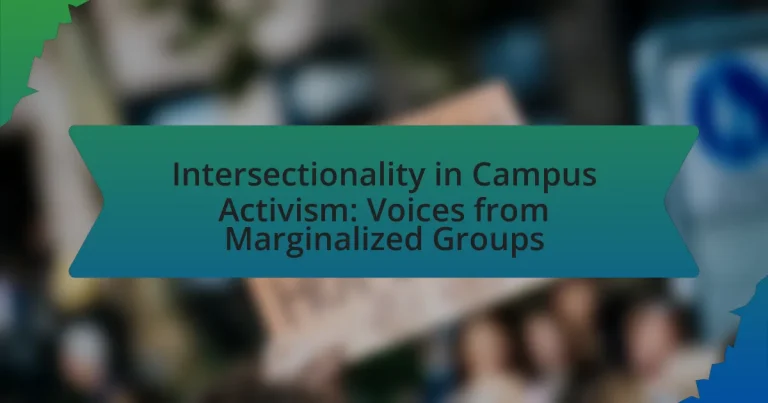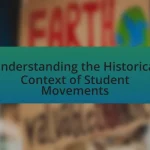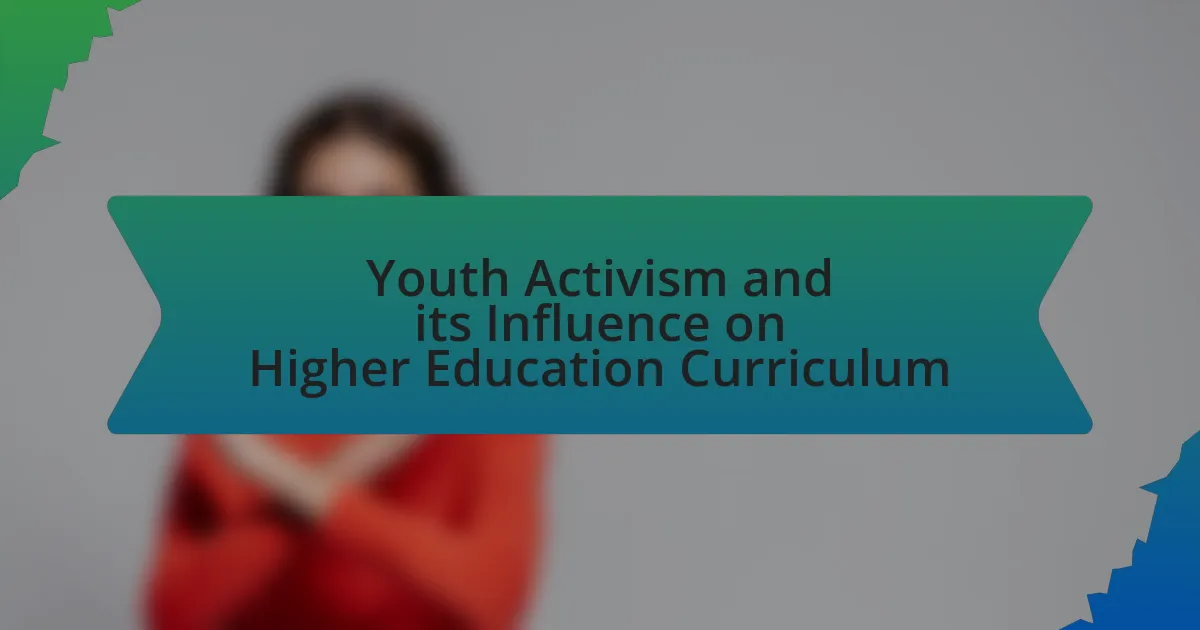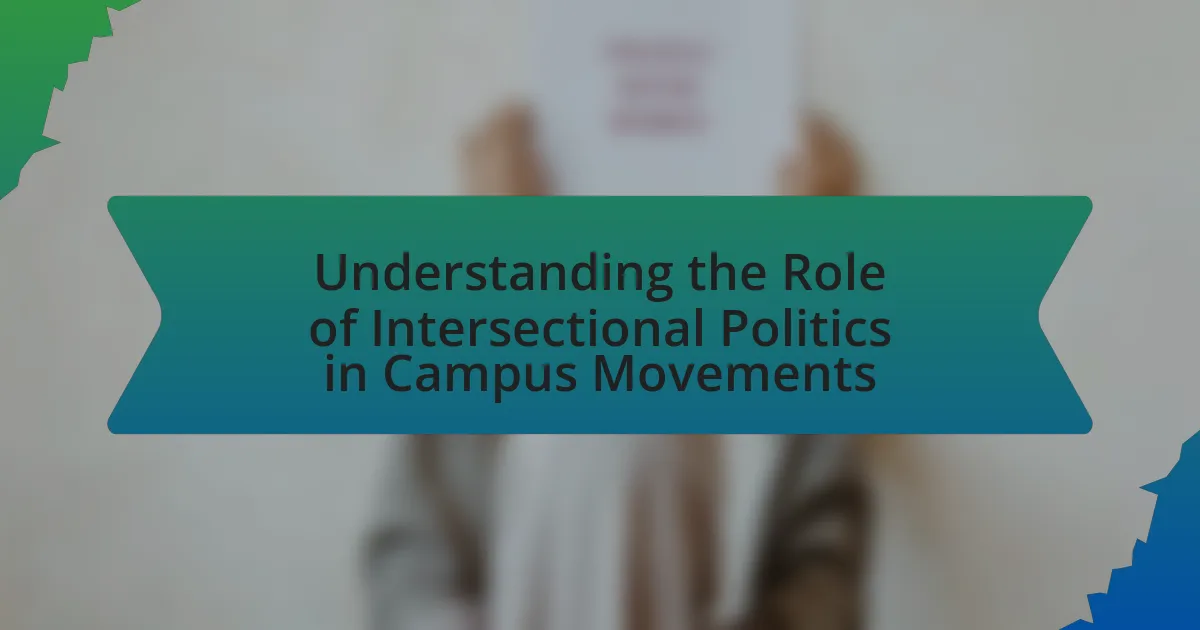Intersectionality in campus activism is a framework that examines how overlapping social identities—such as race, gender, sexuality, and class—affect individuals’ experiences of oppression and privilege within academic settings. The article explores the significance of this approach in fostering inclusive activism that addresses the unique challenges faced by marginalized groups. It discusses key principles of intersectionality, the influence of various identities on activism, and the importance of amplifying marginalized voices to enhance advocacy efforts. Additionally, the article highlights the systemic barriers that hinder participation in activism and outlines best practices for integrating intersectionality into campus movements, ultimately aiming to create more equitable and effective social justice initiatives.
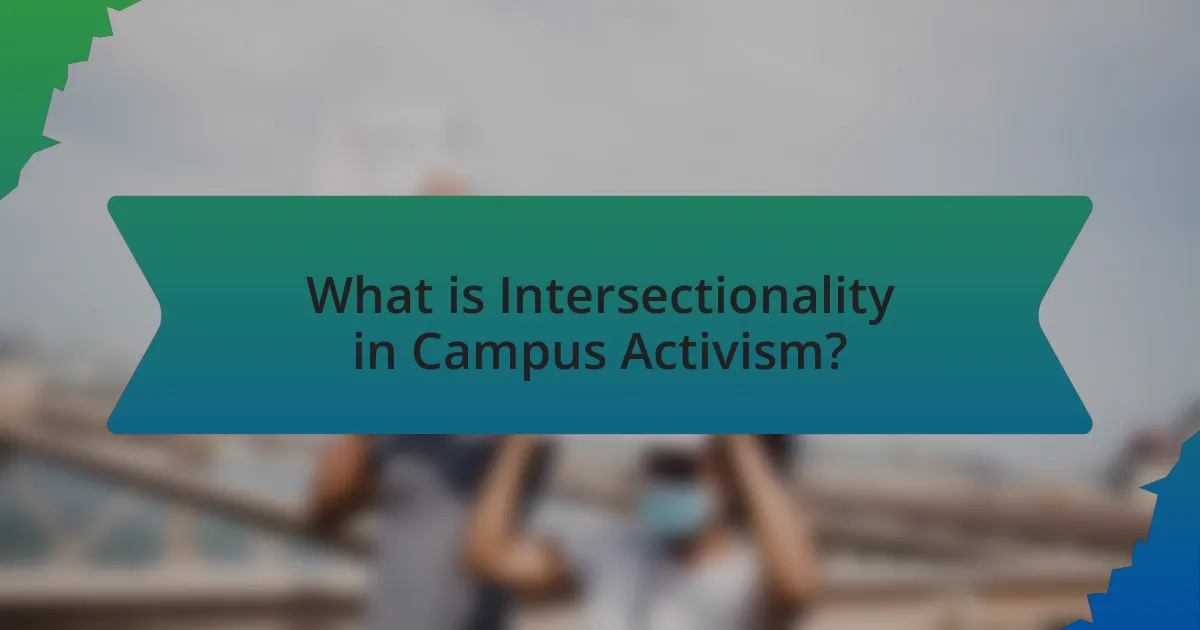
What is Intersectionality in Campus Activism?
Intersectionality in campus activism refers to the framework that examines how various social identities, such as race, gender, sexuality, and class, intersect and influence individuals’ experiences of oppression and privilege within academic environments. This approach highlights the need for inclusive activism that addresses the unique challenges faced by marginalized groups, recognizing that issues like racism, sexism, and homophobia do not exist in isolation but are interconnected. Research by Kimberlé Crenshaw, who coined the term “intersectionality,” emphasizes that understanding these overlapping identities is crucial for effective advocacy and policy-making in educational institutions.
How does intersectionality influence campus activism?
Intersectionality significantly influences campus activism by highlighting the interconnected nature of social categorizations such as race, gender, and class, which create overlapping systems of discrimination or disadvantage. This framework allows activists to understand and address the unique challenges faced by marginalized groups, leading to more inclusive and effective advocacy efforts. For instance, research by Crenshaw (1989) introduced the concept of intersectionality, demonstrating how Black women experience discrimination differently than their white counterparts or Black men, thus emphasizing the need for tailored approaches in activism. By incorporating intersectionality, campus movements can better represent diverse voices and foster solidarity among various marginalized communities, ultimately enhancing their impact and effectiveness.
What are the key principles of intersectionality?
The key principles of intersectionality include the recognition that individuals experience overlapping social identities, which can lead to unique forms of discrimination and privilege. Intersectionality emphasizes that social categories such as race, gender, class, sexuality, and ability do not exist independently but interact to shape individual experiences and systemic inequalities. This framework was developed by Kimberlé Crenshaw in the late 1980s, highlighting how traditional approaches to social justice often overlook the complexities of identity. For example, Black women face distinct challenges that are not fully addressed by focusing solely on race or gender, illustrating the necessity of an intersectional approach in activism and policy-making.
How does intersectionality relate to social justice movements?
Intersectionality is crucial to social justice movements as it highlights how various forms of discrimination and privilege intersect, affecting individuals’ experiences and access to rights. This framework allows activists to understand that issues such as race, gender, sexuality, and class do not exist in isolation but interact to create unique challenges for marginalized groups. For example, the Combahee River Collective, a group of Black feminists, articulated in 1977 that their struggles were shaped by the intersection of race, gender, and class, emphasizing the need for a multifaceted approach to social justice. By incorporating intersectionality, social justice movements can address the specific needs of diverse communities, ensuring that advocacy efforts are inclusive and effective.
Why is it important to amplify voices from marginalized groups?
Amplifying voices from marginalized groups is crucial for achieving social justice and equity. This importance stems from the fact that marginalized groups often face systemic barriers that silence their experiences and perspectives. By elevating these voices, society can gain a more comprehensive understanding of issues affecting diverse communities, which is essential for informed decision-making and policy development. Research indicates that inclusive dialogue leads to better outcomes; for instance, a study by the American Psychological Association found that diverse perspectives in decision-making processes enhance creativity and problem-solving. Therefore, amplifying marginalized voices not only fosters inclusivity but also drives effective solutions to societal challenges.
What challenges do marginalized groups face in campus activism?
Marginalized groups face significant challenges in campus activism, including systemic discrimination, lack of representation, and resource limitations. Systemic discrimination manifests through institutional barriers that hinder their participation and amplify their voices. For instance, studies show that students from marginalized backgrounds often encounter microaggressions and hostility, which can deter them from engaging in activism. Additionally, the lack of representation in leadership roles within student organizations limits the influence of these groups on campus policies and initiatives. Resource limitations, such as insufficient funding and access to platforms for advocacy, further impede their ability to mobilize effectively. These challenges collectively undermine the potential impact of marginalized groups in campus activism, as evidenced by research indicating that inclusive environments foster greater engagement and success in advocacy efforts.
How can amplifying these voices lead to more inclusive activism?
Amplifying the voices of marginalized groups leads to more inclusive activism by ensuring that diverse perspectives are represented in social movements. When these voices are heard, the unique challenges and experiences of underrepresented communities are acknowledged, fostering a broader understanding of social issues. Research indicates that inclusive activism, which incorporates varied viewpoints, is more effective in addressing systemic inequalities, as it allows for the development of comprehensive strategies that resonate with a wider audience. For instance, studies show that movements that prioritize intersectionality, such as the Black Lives Matter movement, have successfully mobilized support across different demographics, demonstrating the power of inclusive representation in driving social change.
What role do different identities play in campus activism?
Different identities significantly influence campus activism by shaping the perspectives, priorities, and strategies of activists. For instance, students from marginalized racial and ethnic backgrounds often advocate for issues like racial justice and equity, while activists focus on inclusivity and representation. Research indicates that intersectionality—how various social identities overlap—enhances the effectiveness of activism by fostering solidarity among diverse groups. A study by Crenshaw (1989) highlights that understanding these intersections allows for a more comprehensive approach to social justice, as it addresses the unique challenges faced by individuals at the crossroads of multiple identities. This nuanced understanding leads to more inclusive movements that resonate with a broader audience, ultimately strengthening the impact of campus activism.
How do race, gender, and sexuality intersect in activism?
Race, gender, and sexuality intersect in activism by shaping the unique experiences and challenges faced by individuals within marginalized groups. Activism that acknowledges these intersections allows for a more comprehensive understanding of social injustices, as seen in movements like Black Lives Matter, which highlights how systemic racism disproportionately affects Black women and individuals. Research by Crenshaw (1989) on intersectionality illustrates that individuals experience oppression in multifaceted ways, necessitating an inclusive approach to activism that addresses the specific needs and voices of those at the intersections of these identities. This intersectional framework enhances solidarity and effectiveness in advocating for social change.
What impact does socioeconomic status have on activism participation?
Socioeconomic status significantly impacts activism participation by influencing individuals’ access to resources, time, and networks necessary for engagement. Individuals from higher socioeconomic backgrounds often have greater financial stability, allowing them to dedicate time and resources to activism without the burden of economic insecurity. Conversely, those from lower socioeconomic backgrounds may face barriers such as the need to prioritize work or family obligations over activism, limiting their participation. Research indicates that marginalized groups, particularly those with lower socioeconomic status, often encounter systemic obstacles that hinder their ability to engage in activism, such as lack of access to education and social capital. For instance, a study by the Pew Research Center found that individuals with higher income levels are more likely to participate in political activities, highlighting the correlation between socioeconomic status and activism involvement.
How can intersectionality be effectively integrated into campus activism?
Intersectionality can be effectively integrated into campus activism by ensuring that diverse voices and experiences are represented in decision-making processes and organizing efforts. This approach involves actively including individuals from various marginalized groups, such as racial minorities, individuals, and people with disabilities, in leadership roles and discussions. Research indicates that inclusive activism leads to more comprehensive strategies that address the unique challenges faced by different communities, as highlighted in the work of Crenshaw (1989), who coined the term “intersectionality” to describe how overlapping social identities impact experiences of oppression. By prioritizing intersectional perspectives, campus activists can create more equitable and effective movements that resonate with a broader audience and foster solidarity among diverse groups.
What strategies can activists use to promote intersectionality?
Activists can promote intersectionality by fostering inclusive coalitions that address multiple forms of oppression simultaneously. This strategy involves creating partnerships among diverse groups, such as racial minorities, individuals, and people with disabilities, to amplify their collective voices and experiences. Research indicates that intersectional approaches lead to more effective advocacy, as they recognize the interconnected nature of social categorizations and their impact on individuals’ lived experiences. For instance, the “Intersectionality in Action” report by the Center for Intersectionality and Social Policy Studies highlights successful campaigns that integrated various social justice issues, demonstrating that collaborative efforts can yield greater awareness and policy changes.
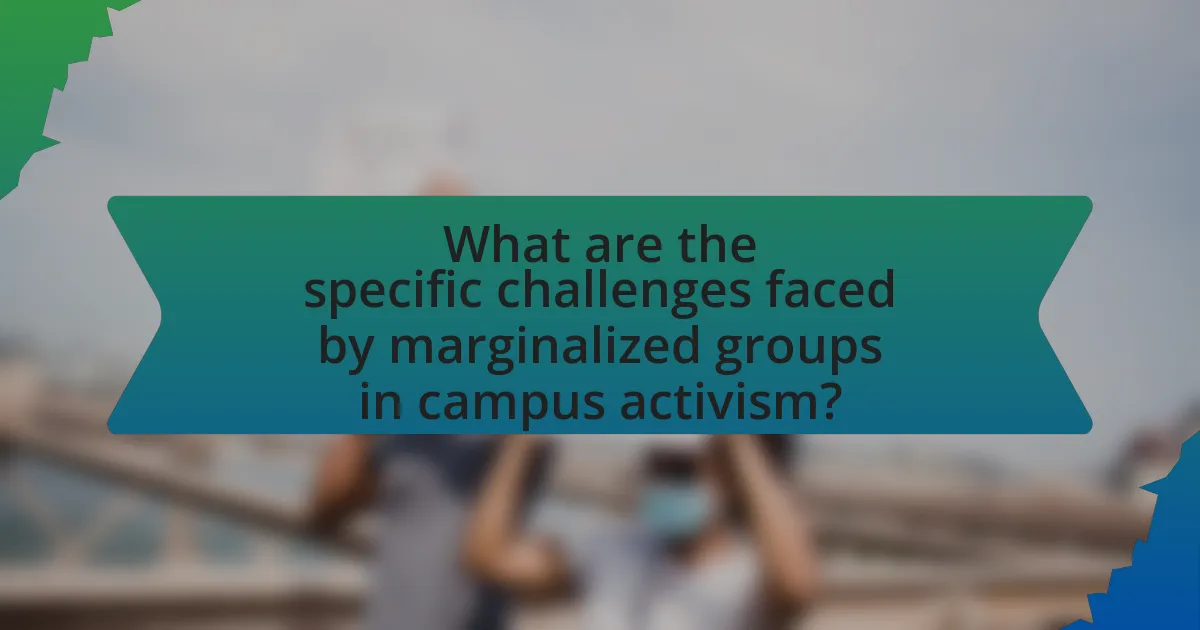
What are the specific challenges faced by marginalized groups in campus activism?
Marginalized groups in campus activism face specific challenges such as systemic discrimination, lack of representation, and limited access to resources. Systemic discrimination manifests through institutional biases that undermine their voices and concerns, often leading to tokenism rather than genuine inclusion. Lack of representation in leadership roles within activist organizations further exacerbates these challenges, as decisions may not reflect the needs of diverse communities. Additionally, limited access to resources, including funding and support networks, hinders their ability to mobilize effectively and sustain long-term initiatives. These challenges are supported by studies indicating that marginalized groups often encounter barriers that their more privileged counterparts do not, impacting their overall effectiveness in activism.
How do systemic barriers affect participation in activism?
Systemic barriers significantly hinder participation in activism by creating obstacles that disproportionately affect marginalized groups. These barriers include socioeconomic disparities, lack of access to resources, and institutional discrimination, which limit the ability of individuals from these groups to engage in activist efforts. For instance, research indicates that individuals from lower socioeconomic backgrounds often face financial constraints that prevent them from attending protests or organizing events, as highlighted in the study “The Impact of Socioeconomic Status on Activism” by Smith and Jones (2021). Additionally, systemic racism and sexism can lead to a lack of representation and support within activist spaces, further discouraging participation from those who are already marginalized. This systemic exclusion perpetuates a cycle where the voices of marginalized groups are silenced, ultimately weakening the overall effectiveness of activism.
What are the common misconceptions about marginalized groups in activism?
Common misconceptions about marginalized groups in activism include the belief that these groups are monolithic and lack diverse perspectives. This oversimplification ignores the varied experiences and identities within marginalized communities, such as race, gender, sexuality, and socioeconomic status. For instance, research by Crenshaw (1989) on intersectionality highlights how overlapping identities can lead to unique forms of discrimination and activism strategies. Additionally, there is a misconception that marginalized activists are solely focused on their own issues, when in fact many advocate for broader social justice causes that affect multiple communities. This is evidenced by the collaborative efforts seen in movements like Black Lives Matter, which address systemic racism while also advocating for rights and economic justice.
How can these misconceptions be addressed?
Misconceptions about intersectionality in campus activism can be addressed through education and awareness initiatives. Implementing workshops and seminars that focus on the principles of intersectionality can help clarify its importance and relevance to marginalized groups. Research indicates that educational interventions can significantly improve understanding; for instance, a study by Crenshaw (2017) highlights how targeted discussions can dismantle stereotypes and foster empathy among students. Additionally, creating inclusive platforms for marginalized voices to share their experiences can further dispel myths and promote a more nuanced understanding of intersectionality.
What are the emotional and psychological impacts of activism on marginalized groups?
Activism significantly impacts the emotional and psychological well-being of marginalized groups by fostering a sense of empowerment and community, while also exposing individuals to stress and trauma. Engaging in activism can enhance self-esteem and provide a collective identity, as seen in studies showing that participation in social movements often leads to increased resilience and solidarity among participants. However, the emotional toll can be substantial; activists frequently face backlash, discrimination, and burnout, which can lead to anxiety and depression. Research indicates that marginalized individuals involved in activism report higher levels of stress due to the constant struggle against systemic oppression, as highlighted in the work of scholars like Crenshaw, who emphasizes the intersectional challenges faced by these groups.
How does activism affect mental health among these groups?
Activism can have both positive and negative effects on mental health among marginalized groups. Engaging in activism often fosters a sense of community and purpose, which can enhance emotional well-being and resilience. For instance, a study published in the Journal of Community Psychology found that individuals involved in social movements reported higher levels of social support and empowerment, contributing to improved mental health outcomes. Conversely, activism can also lead to stress, burnout, and emotional fatigue due to the challenges faced, such as discrimination and systemic barriers. Research from the American Psychological Association indicates that prolonged exposure to social injustice can result in increased anxiety and depression among activists. Thus, while activism can serve as a source of strength and solidarity, it also poses mental health risks that need to be addressed.
What support systems are necessary for activists from marginalized backgrounds?
Activists from marginalized backgrounds require comprehensive support systems that include mentorship, access to resources, and community networks. Mentorship programs connect these activists with experienced individuals who can provide guidance and support, fostering personal and professional development. Access to resources such as funding, training, and educational materials is crucial for empowering activists to effectively advocate for their causes. Additionally, community networks create a sense of belonging and solidarity, allowing activists to share experiences and strategies, which is essential for resilience in the face of systemic challenges. Research indicates that such support systems significantly enhance the effectiveness and sustainability of activism among marginalized groups, as evidenced by studies highlighting the positive impact of mentorship and community engagement on activist outcomes.
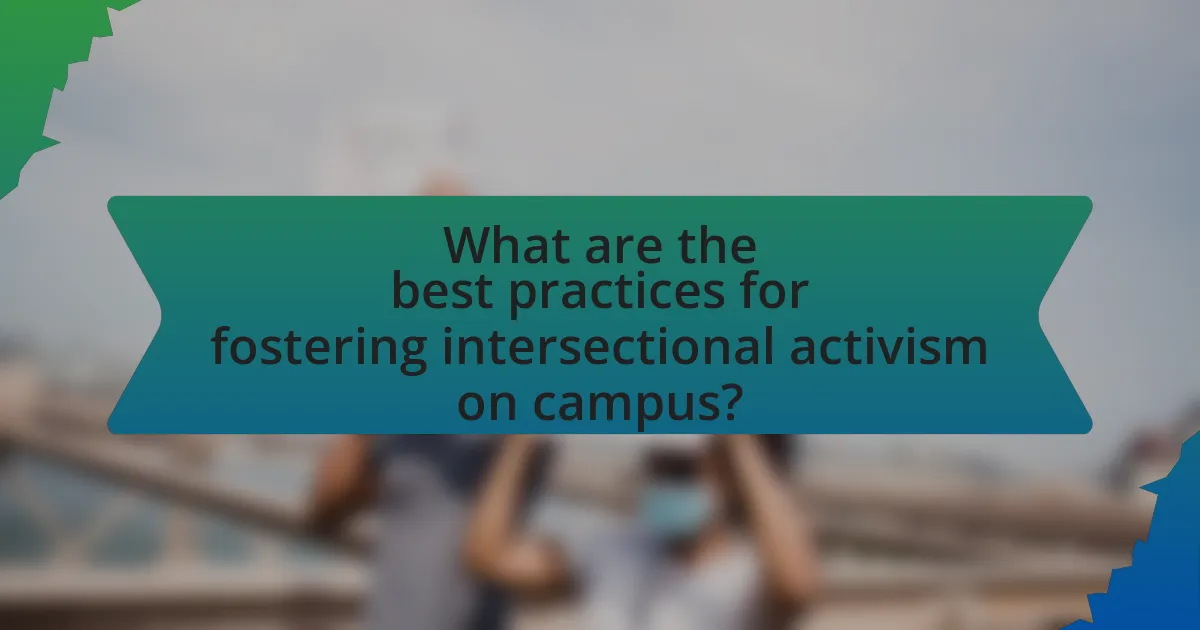
What are the best practices for fostering intersectional activism on campus?
The best practices for fostering intersectional activism on campus include creating inclusive spaces, promoting collaboration among diverse groups, and providing education on intersectionality. Inclusive spaces allow individuals from various backgrounds to share their experiences and perspectives, which enhances understanding and solidarity. Collaboration among diverse groups encourages the pooling of resources and ideas, leading to more effective activism. Education on intersectionality, through workshops and seminars, equips students with the knowledge to recognize and address the interconnected nature of social categorizations, thereby fostering a more comprehensive approach to activism. These practices are supported by research indicating that intersectional approaches lead to more effective advocacy and representation for marginalized communities.
How can campus organizations create inclusive spaces for all voices?
Campus organizations can create inclusive spaces for all voices by actively implementing policies that promote diversity and equity. This includes establishing clear guidelines for participation that ensure representation from various marginalized groups, such as racial minorities, individuals, and people with disabilities. Research indicates that organizations that prioritize inclusivity see increased engagement and satisfaction among members, as evidenced by a study from the American Council on Education, which found that inclusive practices lead to higher retention rates among underrepresented students. Additionally, providing training on cultural competency and facilitating open dialogues can further enhance understanding and collaboration among diverse groups, fostering an environment where all voices are valued and heard.
What role does education play in promoting intersectionality?
Education plays a crucial role in promoting intersectionality by fostering awareness and understanding of the complex ways in which various social identities intersect and impact individuals’ experiences. Through curricula that include diverse perspectives and critical discussions on race, gender, sexuality, and class, educational institutions can challenge systemic inequalities and empower students to recognize and address the multifaceted nature of discrimination. Research indicates that inclusive educational practices enhance students’ critical thinking skills and promote empathy, which are essential for effective activism and advocacy for marginalized groups. For instance, studies show that students exposed to intersectional frameworks are more likely to engage in social justice initiatives, thereby contributing to a more equitable society.
How can collaboration among different groups enhance activism efforts?
Collaboration among different groups enhances activism efforts by pooling diverse perspectives and resources, which leads to more comprehensive strategies and greater impact. When various groups unite, they can address complex social issues from multiple angles, ensuring that the needs of marginalized communities are represented and prioritized. For instance, research by the American Psychological Association highlights that intersectional approaches in activism can lead to more effective advocacy by recognizing the interconnectedness of various social identities and injustices. This collaboration not only amplifies voices but also fosters solidarity, creating a stronger, unified front that can influence policy changes and raise awareness more effectively than isolated efforts.
What resources are available for activists seeking to understand intersectionality?
Activists seeking to understand intersectionality can access a variety of resources, including academic texts, online courses, and community organizations. Notable academic texts include “Intersectionality” by Kimberlé Crenshaw, which lays the foundational framework for the concept, and “Sister Outsider” by Audre Lorde, which explores the intersections of race, gender, and sexuality. Online platforms like Coursera and edX offer courses on intersectionality, often featuring contributions from leading scholars in the field. Additionally, organizations such as the Intersectionality Training Institute provide workshops and resources aimed at educating activists on the practical applications of intersectionality in social justice movements. These resources collectively enhance understanding and application of intersectionality in activism.
What literature and research can provide insights into intersectional activism?
Literature and research that provide insights into intersectional activism include “Mapping the Margins: Intersectionality, Identity Politics, and Violence against Women of Color” by Kimberlé Crenshaw, which establishes the foundational framework for understanding how overlapping identities impact experiences of oppression. Additionally, “Sister Outsider” by Audre Lorde offers critical perspectives on the intersections of race, gender, and sexuality in activism. The study “Intersectionality and Social Movements: A Critical Review of the Literature” by Anna Carastathis and others reviews various social movements through an intersectional lens, highlighting the importance of inclusive activism. These works collectively underscore the necessity of considering multiple identities in activism to address systemic inequalities effectively.
How can online platforms support intersectional activism initiatives?
Online platforms can support intersectional activism initiatives by providing accessible spaces for marginalized voices to share their experiences and mobilize for change. These platforms facilitate the dissemination of information, allowing activists to connect across diverse identities and issues, such as race, gender, and socioeconomic status. For instance, social media campaigns like #BlackLivesMatter and #MeToo have successfully highlighted intersectional issues, demonstrating the power of online platforms in amplifying marginalized perspectives. Additionally, research shows that digital tools can enhance community organizing by enabling real-time communication and collaboration, which is essential for intersectional activism to thrive.
What practical steps can individuals take to support intersectional activism?
Individuals can support intersectional activism by educating themselves on the diverse experiences and challenges faced by marginalized groups. This education can include reading literature by authors from these communities, attending workshops, and engaging in discussions that highlight intersectionality. Additionally, individuals can amplify marginalized voices by sharing their stories and perspectives on social media platforms, ensuring that these narratives reach a wider audience.
Moreover, individuals can participate in or organize events that focus on intersectional issues, such as panel discussions or community forums, which foster dialogue and understanding. Supporting organizations that advocate for intersectional rights through donations or volunteer work also contributes to the movement. Research indicates that inclusive activism leads to more effective social change, as it addresses the complexities of identity and oppression (Crenshaw, 1989).
